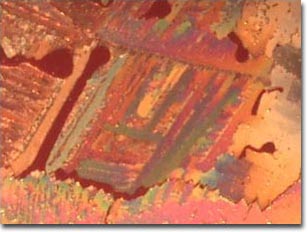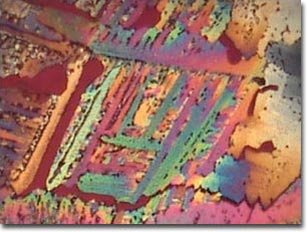Advanced Condenser Systems: Achromatic Condensers
Recrystallized Urea
The images below compare performance of the Intel Play QX3 Computer Microscope with and without the aid of an organized cone of illumination from an achromatic substage condenser containing an aperture diaphragm. These photomicrographs are unretouched and were captured with the QX3 interactive software.
Urea Crystallites in Polarized Light


Excess nitrogen in the body is excreted in one of three forms: ammonia (as the ammonium ion), urea, and uric acid. Animals, such as fish, that live in the water excrete nitrogen as ammonia, which is quickly diluted by the aqueous environment. In terrestrial animals, the primary waste product of nitrogen metabolism is urea, a water-soluble compound. Birds excrete excess nitrogen in the form of uric acid, an insoluble chemical that allows birds to remove nitrogen without the use of water.
Both images above are crystallites of trinitrotoluene (TNT), taken with polarized light and a full-wave retardation plate. The image on the top was recorded with a stock QX3 microscope after adding the polarizer and analyzer. On the bottom is an image recorded with the QX3 body with the assistance of an achromatic substage condenser (Nikon) using the same components in the optical pathway.
BACK TO TRANSMITTED POLARIZED ILLUMINATION GALLERY
